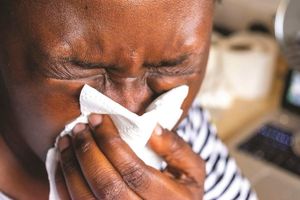
As the typical flu season progresses, health officials are keeping a close eye on the situation.
"My daughter was like a walking virus collection," says a visibly exhausted mother in Nairobi. Her four-year-old tested positive for not one, but four different viruses simultaneously – Influenza A, Respiratory Syncytial Virus (RSV), Rhinovirus, and Corona Fever. What's even more concerning? Her tiny body has rejected three different antibiotics that doctors have tried.
The child is just one face of a worrying health crisis quietly sweeping across Kenya, where hundreds are battling an antibiotic-resistant strain of Influenza A, according to Public Health and Professional Standards PS Mary Muthoni.
"She must have caught it at school," the young mother tells me at her Nairobi home, where her daughter is finally on the mend after a frightening hospital stay. "When I took her to Gertrude's Children Hospital, the waiting room was packed with parents who had brought children around the same age with identical symptoms."
After several failed antibiotic treatments – amoxicillin, azithromycin and zinnat all proved ineffective – doctors had to get creative with alternative medicines. "The baby is better now. I was told to give her fruits, especially pineapples, which have helped a lot."
This family's ordeal isn't unique. A Nation spot check across 10 counties reveals similar stories unfolding from Mombasa to Marsabit, with Kiambu County resident Magdalene Kamau among those hard hit.
"My husband and I have spent two weeks in hospital with this thing," Kamau says from her hospital bed, where she's finally being discharged. "This flu is from hell – I've been coughing like a hippo." Interestingly, their son somehow escaped infection, a small mercy in an otherwise brutal experience.
So what's behind this nationwide misery? Climate change, apparently.
"Our unpredictable weather patterns are fuelling the spread," PS Muthoni explains during our exclusive interview. She points to detailed test results showing that of 349 samples collected from nine sentinel sites around the country, 91 came back positive for Influenza A – a concerning 26 percent positivity rate.
"Climate change significantly impacts how Influenza A transmits by altering temperature and humidity patterns," she adds. "These changes affect virus stability, animal migration, and human behaviour, which can extend flu seasons and potentially help new strains emerge."
The current outbreak appears to have started in February in Banisa Sub-county, Mandera County, where 140 households in Tarbey village were affected. The situation was so serious that 105 people ended up in hospital and, sadly, one person died.
"We immediately sent a response team to investigate," PS Muthoni says. The team collected 30 respiratory samples from patients at various hospitals in the area. Six tested positive for Influenza A, with a mix of H1N1, H3, and some strains that couldn't be immediately identified.
Here's what makes this outbreak particularly tricky: Kenya typically sees respiratory infections peak twice annually – late February through May, and again from July to mid-October. We're now in the middle of what should be a normal seasonal increase, but the antibiotic resistance is throwing healthcare providers for a loop.
Dr Jeremy Gitau, who runs Daktari Msafiri, a home healthcare service, says his team has been treating 10-15 Influenza A patients a week for the past three weeks.
"Most recover well with antihistamines and fever reducers," he explains. "But some develop pneumonia and need stronger interventions." His advice for those battling the disease echoes what helped the four-year-old: nutrient-rich foods and plenty of fluids.
Despite the uncomfortable symptoms and resistance to common antibiotics, PS Muthoni insists there's "no cause for alarm", as the condition remains "manageable and treatable".
However, she strongly discourages Kenyans from self-medicating with over-the-counter antibiotics – a common practice that could be contributing to the resistance problem.
"Go get properly tested," she urges. "And please, wear masks if you're experiencing symptoms to protect others."
As the typical flu season progresses, health officials are keeping a close eye on the situation.
***
FACT BOX: UNDERSTANDING INFLUENZA A
What is Influenza A?
Influenza A is one of the four types of influenza viruses (A, B, C and D). It's known to cause seasonal epidemics and occasional pandemics. Influenza A viruses are constantly changing and are classified into subtypes based on the combination of proteins on their surface (hemagglutinin and neuraminidase), such as H1N1 and H3N2.
Symptoms
- Sudden onset of high fever (typically higher than ordinary flu)
- Severe muscle aches and body pains
- Extreme fatigue and weakness
- Headache
- Dry cough
- Sore throat
- Runny or stuffy nose
- In some cases, nausea, vomiting, and diarrhoea (more common in children)
How It Spreads
Influenza A spreads primarily through:
- Respiratory droplets when infected people cough, sneeze or talk
- Touching surfaces contaminated with the virus and then touching your face
- Close contact with infected individuals
- The virus can remain infectious on surfaces for 24-48 hours
How Influenza A differs from ordinary flu
- Severity: Typically causes more severe symptoms and complications than other flu types
- Epidemic potential: More likely to cause widespread outbreaks and pandemics
- Mutation rate: Changes more rapidly, potentially leading to resistance against existing immunity
- Host range: Can infect humans, birds, pigs and other animals (ordinary flu is mainly human-specific)
- Complication risk: Higher likelihood of developing pneumonia, respiratory failure and other serious complications
- Impact: Generally causes more hospitalisations and deaths than other influenza types
Sources: WHO, Centers for Disease Control and Prevention (CDC)
National Institutes of Health (NIH) and
Kenya Ministry of Health











